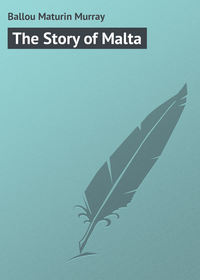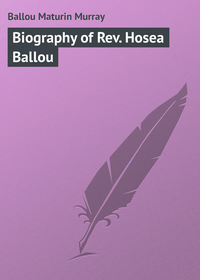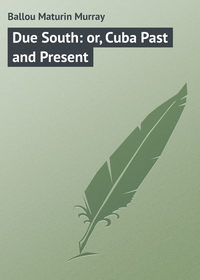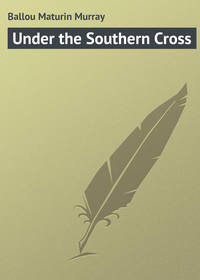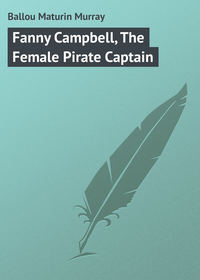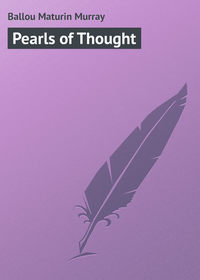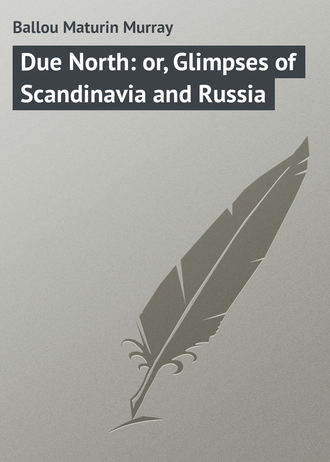 полная версия
полная версияDue North: or, Glimpses of Scandinavia and Russia

Ballou Maturin Murray
Due North or Glimpses of Scandinavia and Russia
PREFACE
About five years ago, the Author, having then just returned from circumnavigating the globe, was induced to record his experiences of the long journey, which were published in a volume entitled "Due West; or, Round the World in Ten Months." The public favor accorded to this work led, a couple of years later, to the issuing of a second volume of travels, upon the Author's return from the West Indies, entitled "Due South; or, Cuba, Past and Present." The popular success of both books and the flattering comments of the critics have caused the undersigned to believe that a certain portion of the public is pleased to see foreign lands and people through his eyes; and hence the publication of the volume now in hand. These pages describing the far North, from which the Author has just returned, – including Norway, Sweden, Russia, and Russian Poland, – seem naturally to suggest the title of "Due North." Without permitting prejudice to circumscribe judgment in treating of Russia, the effort has been to represent the condition of that country and its Polish province truthfully, and to draw only reasonable deductions. This special reference is made to the pages relating to the Tzar's government, as it will be found that the Author does not accord with the popularly expressed opinion upon this subject.
M. M. B.Boston, March, 1887.
CHAPTER I
Copenhagen. – First Stroll in a Strange City. – Danish Children. – Antiquity of Copenhagen. – English Arrogance. – The Baltic Sea. – Danish Possessions. – Descendants of the Vikings. – Covetous Germany. – The Denmark of To-day. – Thorwaldsen's Remarkable Museum. – The Ethnological Museum. – Educational Matters. – Eminent Natives. – Charitable Institutions. – Antique Churches. – Royal Palaces. – Historical Memories. – City Architecture. – Zoölogical GardensHaving resolved upon a journey due north, twenty days of travel over familiar routes carried the author across the Atlantic and, by the way of Liverpool, London, Paris, and Hamburg, landed him in Copenhagen, the pleasant and thrifty capital of Denmark. As the following pages will be devoted to Scandinavia, Russia, and Russian Poland, this metropolis seems to be a proper locality at which to begin the northern journey with the reader.
It was already nearly midnight when the Hôtel D'Angleterre, fronting upon the Kongens Nytorv, was reached. So long a period of uninterrupted travel, night and day, rendered a few hours of quiet sleep something to be gratefully appreciated. Early the next morning the consciousness of being in a strange city, always so stimulating to the observant traveller, sent us forth with curious eyes upon the thoroughfares of the Danish capital before the average citizen was awake. The importunities of couriers and local guides, who are always on the watch for visitors, were at first sedulously ignored; for it would be foolish to rob one's self of the great pleasure of a preliminary stroll alone amid scenes and localities of which one is blissfully ignorant. A cicerone will come into the programme later on, and is a prime necessity at the proper time; but at the outset there is a keen gratification and novelty in verifying or contradicting preconceived ideas, by threading unattended a labyrinth of mysterious streets and blind alleys, leading one knows not where, and suddenly coming out upon some broad square or boulevard full of unexpected palaces and grand public monuments.
It was thus that we wandered into the old Market Square where Dietrick Slagheck, Archbishop of Lund and minister of Christian II., was burned alive. A slight stretch of the imagination made the place still to smell of roasted bishop. "Is this also the land of wooden shoes?" we asked ourself, as the rapid clatter of human feet upon the pavements recalled the familiar street-echoes of Antwerp. How eagerly the eye receives and retains each new impression under such circumstances! How sharp it is to search out peculiarities of dress, manners, architecture, modes of conveyance, the attractive display of merchandise in shop-windows, and even the expression upon the faces of men, women, and children! Children! if any one says the Danish children are not pretty, you may with safety contradict him. Their delicately rounded, fresh young faces are lit up by such bright, turquoise-colored, forget-me-not blue eyes as appeal to the heart at once. What a wholesome appetite followed upon this pioneer excursion, when we entered at breakfast on a new series of observations while satisfying the vigorous calls of hunger, each course proving a novelty, and every dish a fresh voyage of gastronomic discovery!
Copenhagen was a large commercial port many centuries ago, and has several times been partially destroyed by war and conflagration. It has some two hundred and fifty thousand inhabitants, and is about six miles in circumference. The site of the city is so low as to render it necessary to protect it from the waters of the Baltic by artificial embankments. Like Amsterdam and Venice, it may be said to possess "remarkable water-privileges." We were told that the citizens were making earnest remonstrance as to the inefficient drainage of the city, which is believed to be the prime cause of a somewhat extraordinary percentage of mortality. In past times it has more than once been visited by the plague, which so late as 1711 caused the death of over twenty-eight thousand of its inhabitants. It is only some thirty years since, that over five thousand persons died here of cholera in one season. Fevers of a typhoid character prevail annually, which are no doubt with good reason attributed to want of proper drainage. Notwithstanding Copenhagen is situated so nearly at tide level, modern engineering could easily perfect a system of drainage which would render it independent of this circumstance. The safe and spacious harbor is formed by the channel between the islands of Zeeland and Amager, where there is ample depth and room to answer the demands of a far more extended commerce than the city is ever likely to maintain. The houses are mostly of brick, some of the better class being built of Norwegian granite, while the newer portion of the town presents many examples of fine modern architecture. The streets are of good width and laid out with an eye to regularity, besides which there are sixteen spacious public squares. Taken as a whole, the first impression of the place and its surroundings is remarkably pleasing and attractive. As one approaches the city, the scene is enlivened by the many windmills in the environs, whose wide-spread arms are generally in motion, appearing like the broad wings of enormous birds hovering over the land and just preparing to alight. One is hardly surprised that Don Quixote should mistake them for palpable enemies, and charge upon them full tilt. Perhaps the earliest associations in its modern history which the stranger is likely to remember, as he looks about him in Copenhagen, is that of the dastardly attack upon the city, and the shelling of it for three consecutive days, by the British fleet in 1807, during which uncalled for and reckless onslaught an immense destruction of human life and property was inflicted upon the place. Over three hundred important buildings were laid in ashes on that occasion, because Denmark refused permission for the domiciling of English troops upon her soil, and declined, as she had a most unquestionable right to do, to withdraw her connection with the neutral powers. It was one of the most outrageous examples of English arrogance on record, – one which even her own historians feel compelled to denounce emphatically. No wonder the gallant Nelson expressed his deep regret at being sent to the Baltic on such distasteful service. Copenhagen received the expressive name it bears (Merchant's Haven) on account of its excellent harbor and general commercial advantages. As in the Mediterranean so in the Baltic, tidal influence is felt only to a small degree, the difference in the rise and fall of the water at this point being scarcely more than one foot. It should be remembered, however, that the level of the waters of the Baltic are subject, like those of the Swiss lakes, to barometric variations. Owing to the comparatively fresh character of this sea, its ports are ice-bound for a third of each year, and in extreme seasons the whole expanse is frozen across from the Denmark to the Swedish coast. In 1658, Charles X. of Sweden marched his army across the Belts, dictating to the Danes a treaty of peace; and so late as 1809, a Russian army passed from Finland to Sweden across the Gulf of Bothnia.
The possessions of Denmark upon the main-land are in our day quite circumscribed, consisting of Jutland only; but she has besides several islands far and near, of which Zeeland is the most populous, and contains the capital. As a State, she may be said to occupy a much larger space in history than upon the map of Europe. The surface of the island of Zeeland is uniformly low, in this respect resembling Holland, the highest point reaching an elevation of but five hundred and fifty feet. To be precise in the matter of her dominions, the colonial possessions of Denmark may be thus enumerated: Greenland, Iceland, the Faroe group of islands, between the Shetlands and Iceland; adding St. Croix, St. Thomas, and St. John in the West Indies. Greenland is nearly as large as Germany and France combined; but its inhabitants do not quite reach an aggregate of ten thousand. Iceland is about the size of our New England States, and has a population of seventy-five thousand. The Faroes contain ten thousand inhabitants, and the three West Indian islands united have a population of a little over forty thousand.
A slight sense of disappointment was realized at not finding more visible evidences of antiquity while visiting the several sections of the capital, particularly as it was remembered that a short time since, in 1880, the Danish monarchy reached the thousandth anniversary of its foundation under Gorm the Old, whose reign bridges over the interval between mere legend and the dawn of recorded history. Gorm is supposed to have been a direct descendant of the famous Viking, Regnar Lodbrog, who was a daring and imperious ruler of the early Northmen. The common origin of the three Baltic nationalities which constitute Scandinavia is clearly apparent to the traveller who has visited Denmark, Sweden, and Norway, or to any one who has even an ordinary knowledge of their history. The race has been steadily modified, generation after generation, in its more vivid characteristics, by the progressive force of civilization. These Northmen are no longer the haughty and reckless warriors who revelled in wine drunk from the skulls of their enemies, and who deemed death only respectable when encountered upon the battle-field. Clearer intelligence and culture have substituted the duties of peaceful citizens for those of marauders, and the enterprises of civilized life for the exaggerated romance of chivalry. Reading and writing, which were looked upon among them as allied to the black art a few centuries ago, are now the universal accomplishment of all classes, and nowhere on the globe will the traveller find a people more cheerful, intelligent, frank, and hospitable than in the three kingdoms of the far North.
Though the Danes are physically rather small, resembling in this respect the Japanese, still they spring, as we have seen, from a brave and warlike race, and have never been subjugated by any other people. On the contrary, in the olden time they conquered England, dismembered France, and subjugated Norway and Sweden. The time has been when the Danes boasted the largest and most efficient navy in the world, and their realm still justly bears the title of "Queen of the Baltic." As to seamanship, they are universally acknowledged to be among the best sailors who navigate the ocean. That Germany covets Denmark is more than hinted at. The author heard a loud-talking naval gentleman, of German nationality, coolly express the opinion that Denmark as an independent kingdom had nearly reached the close of its existence. This was on board the German mail-steamer, while crossing a branch of the Baltic between the ports of Kiel and Korsoer. Whether this individual reflected the ambitious purposes of the present German government, or only echoed a popular sentiment of his nation, the reader is left to judge. Were Bismarck to attempt, upon any subterfuge, to absorb Denmark, it is reasonable to suppose that other European powers would have something to say upon the subject; but that the map of Europe, as now constructed, is destined to undergo radical changes in the near future cannot be doubted.
The Denmark of to-day, typified by Copenhagen its capital, is a great centre of science and of art, quite as much so as are Munich or Dresden. It is surprising that so few travellers, comparatively, resort thither. For the study of ethnological subjects, there is no country which affords greater facilities, or which is more interesting to scientists generally. The spirit of Thorwaldsen here permeates everything; and in making his native city his heir, he also bequeathed to her an appreciation of art, which her eminent scientists have ably supplemented in their several departments of knowledge. To visit the unique Thorwaldsen Museum alone would repay a journey to Copenhagen, and no visitor to this Venice of the North should fail thoroughly to explore its riches. It is in the very centre of the city, situated close to the Palace of Christiansborg, and was erected in 1845 from the great sculptor's own design, based on the Egyptian order of architecture. It is two stories in height, and quadrangular in form, – the lower story containing sculpture only; the upper, both statuary and pictures. The external aspect of the structure is certainly not pleasing, but within, "where the marble statues breathe in rows," may be seen collected together and appropriately arranged six hundred of the great master's works, exhibiting the splendid and it is believed, as regards this department of art, unequalled result of one man's genius and industry. With galleries and vestibules the Museum contains over forty apartments, ample space being afforded for the best display of each figure and each group. The ceilings are elaborately and very beautifully decorated with emblematical designs by the best Danish artists. This enduring monument to art is also Thorwaldsen's appropriate mausoleum, being fashioned externally after an Etruscan tomb, and decorated in fresco with scenes illustrative of the sculptor's life. These crude and unprotected frescos, however, have become quite dim, and are being gradually effaced by exposure to the elements. So far as any artistic effect is concerned, we are honestly forced to say that the sooner they disappear the better. The interior of the Museum is peculiar in its combined effect, – a little depressing, we thought, being painted and finished in the sombre Pompeian style. It contains only Thorwaldsen's works and a few pictures which he brought with him when he removed hither from Rome, where so many years of his artistic life were passed. We have here presented to us the busts, models, sketches, and forms in clay, plaster, or marble, which represent all his works. Thorwaldsen's favorite motto was: "The artist belongs to his work, not the work to the artist," – a conscientious devotion which seems to invest everything which came from his hand. His body lies buried in the centre of the open court about which the building is constructed, without any designating stone, the ground being slightly raised above the surrounding pavement, and appropriately covered with a bed of growing ivy. A sense of stillness and solemnity seems to permeate the atmosphere as one pauses beside this lowly but expressive mound.
Among the portrait-statues which linger in the memory are many historic and familiar characters, such as Copernicus, Byron, Goethe, Hans Andersen, Humboldt, Schiller, Horace Vernet, Christian IV., the favorite monarch of the Danes, and many more. We have said that the general effect of these artistic halls was a little depressing; still, this was not the influence of the great sculptor's creations, for they are full of the joyous, elevating, and noble characteristics of humanity. Thorwaldsen revelled in the representation of tenderness, of youth, beauty, and childhood. Nothing of the repulsive or terrible ever came from his hand. The sculptor's regal fancy found expression most fully, perhaps, in the relievi which are gathered here, illustrating the delightful legends of the Greek mythology. He gives us here in exquisite marble his original conceptions of what others have depicted with the pen and the brush. No one can wonder at the universal homage accorded by his countrymen to the memory of the greatest of modern sculptors. The bust of Luther is seen in the main hall in an unfinished condition, just as the sculptor left it, and upon which, indeed, he is said to have worked the day before his death. It depicts a rude, coarse face, but one full of energy and power. In the Hall of Christ, as it is called, is the celebrated group of our Lord and the Twelve Disciples, the original of which is in the Cathedral. The impressive effect of this remarkable group is universally conceded; no one can stand before it unaffected by its grand and solemn beauty. Thorwaldsen's household furniture, writing-desk, books, pictures, and relics are here disposed as they were found in his home on the day of his death, – among which a clock, made by him when he was but twelve years of age, will interest the visitor.
A large proportion of the many persons whom we met in the Museum were Danes, whose respectability and admirable behavior impressed us most favorably, – a conviction which was daily corroborated upon the public streets, where there was none of the grossness observable which is so glaring among the middle and lower classes of more southern cities. There are no mendicants upon the thoroughfares; order and cleanliness reign everywhere, reminding one of Holland and the Hague. The young trees and delicate flowers in the public gardens require no special protection, and one looks in vain for anything like rowdyism in the crowded thoroughfares. Though the Danes are free consumers of malt liquors, not a case of intoxication met the author's eye while he remained in Copenhagen.
The Ethnological Museum of the city, better known as the Museum of Northern Antiquities, is generally considered to be the most remarkable institution of its class in Europe. Students in this department of science come from all parts of the civilized world to seek knowledge from its countless treasures. One is here enabled to follow the progress of our race from its primitive stages to its highest civilization. The national government liberally aids all purposes akin to science and art; consequently this Museum is a favored object of the State, being also liberally endowed by private munificence. Each of the three distinctive periods of Stone, Bronze, and Iron forms an elaborate division in the spacious halls of the institution. In classifying the objects, care has been taken not only to divide the three great periods named, but also in each of these divisions those belonging to the beginning and the end of the period are chronologically placed, as fast as such nice distinctions can be wrought out by careful, scientific study and comparison. Here the visitor gazes with absorbing interest upon the tangible evidences of a race that inhabited this earth probably thousands of years before it was broken into islands and continents. Their one token, these rude, but expressive stone implements, are found equally distributed from the Arctic Circle to the Equator, from Canada to Brazil, from England to Japan. Scientists whose culture and intelligence entitle their opinion to respect, place the Stone Age as here illustrated at least twenty thousand years before the birth of Christ. How absorbing is the interest attaching to these relics which ages have consecrated! No matter what our preconceived notions may be, science only deals with irrefutable facts. The periods delineated may be thus expressed: first the Flint period, which comes down to fifteen hundred years before Christ; followed by the Bronze, which includes the next twelve or thirteen hundred years; then the Iron, which comes down far into the Christian era. What is termed the Mediæval brings us to 1536, since which time there is no occasion for classification. No wonder the antiquarian becomes so absorbed in the study of the past. "The earliest and the longest has still the mastery over us," says George Eliot. Progress is daily making in the correct reading of these comprehensive data, and those who may come after us will be born to a great wealth of antiquity. Other countries may learn much from the admirable management of this Museum in the matter of improving the educational advantages which it affords. Professors of eminence daily accompany the groups of visitors, clearly explaining the purport and the historical relations of the many interesting objects. These persons are not merely intelligent employees, but they are also trained scientists; and, above all, they are enthusiastic in freely imparting the knowledge which inspires them. Such impromptu lectures are both original and impressive. Indeed, to go through the Ethnological Museum of Copenhagen understandingly is a liberal education. It should be added that the zeal and affability of these able officials is as freely and cheerfully extended to the humblest citizen as to distinguished strangers. One returns again and again with a sort of fascination to these indisputable evidences of history relating to periods of which there is no written record. If they are partially defective in their consecutive teachings, they are most impressive in the actual knowledge which they convey. Without giving us a list of sovereigns or positive dates, they afford collectively a clearer knowledge of the religion, culture, and domestic life of the people of their several periods than a Gibbon or a Bancroft could depict with their glowing pages.
The Danes are a cultured people, much more so, indeed, than the average classes of the continental States. The large number of book-stores was a noticeable feature of the capital, as well as the excellent character of the books which were offered for sale. These were in German, French, and English, the literature of the latter being especially well represented. Copenhagen has more daily and weekly newspapers, magazines, and current news publications than Edinburgh or Dublin, or most of the provincial cities of Great Britain. It may be doubted if even in this country, outside of New England, we have many districts more liberally supplied with free library accommodations, or with educational facilities for youth, than are the populous portions of Zeeland and Jutland. Even small country villages have their book-clubs and dramatic clubs. A very general taste for the drama prevails. Indeed, Denmark has a national drama of its own, which exercises a notable influence upon its people. This Government was the first in Europe to furnish the means of education to the people at large on a liberal scale, to establish schoolhouses in every parish, and to provide suitable dwellings and incomes for the teachers. The incipient steps towards this object began as far back as the time of Christian II., more than three centuries ago, while most of the European States were grovelling in ignorance. Copenhagen has two public libraries, – the Royal, containing over six hundred thousand books; and the University, which has between two hundred and fifty and three hundred thousand volumes, not to speak in detail of a particularly choice collection of manuscripts. These under reasonable restrictions are free to all, citizen or foreigner. The National University is of the first class, and supports a well organized lecture-system, like that of the Sorbonne in Paris, and which is also free to all, women having the same facilities afforded them as those enjoyed by the sterner sex. This institution, we were assured, is conducted upon the most modern educational system. It was founded in 1478, and at the present writing has between twelve and fifteen hundred students, instructed by about fifty able professors.
Though Denmark is a small kingdom, containing scarcely three millions of people, yet it has produced many eminent men of science, of art, and of literature. The names of Hans Christian Andersen, of Rasmus Rask the philologist, of Oersted the discoverer of electro-magnetism, of Forchhammer the mineralogist, and Eschricht the physiologist, will occur to the reader's mind in this connection. It is a country of legend and romance, of historic and prehistoric monuments, besides being the very father-land of fairy tales. The Vikings of old have left their footprints all over the country in barrows and tumuli. It is not, therefore, surprising that the cultured portion of the community are stimulated to antiquarian research. The masses are clearly a pleasure-loving people, easily amused and contented, troubling themselves very little about religious matters; the arts, poetry, and the drama being much more reverenced than the church. The accepted and almost universal doctrine is that of Lutheranism. One meets comparatively few intelligent persons who cannot speak English, while many speak French and German also. The Danish language is a modified form of the old Gothic, which prevailed in the earliest historic ages.


